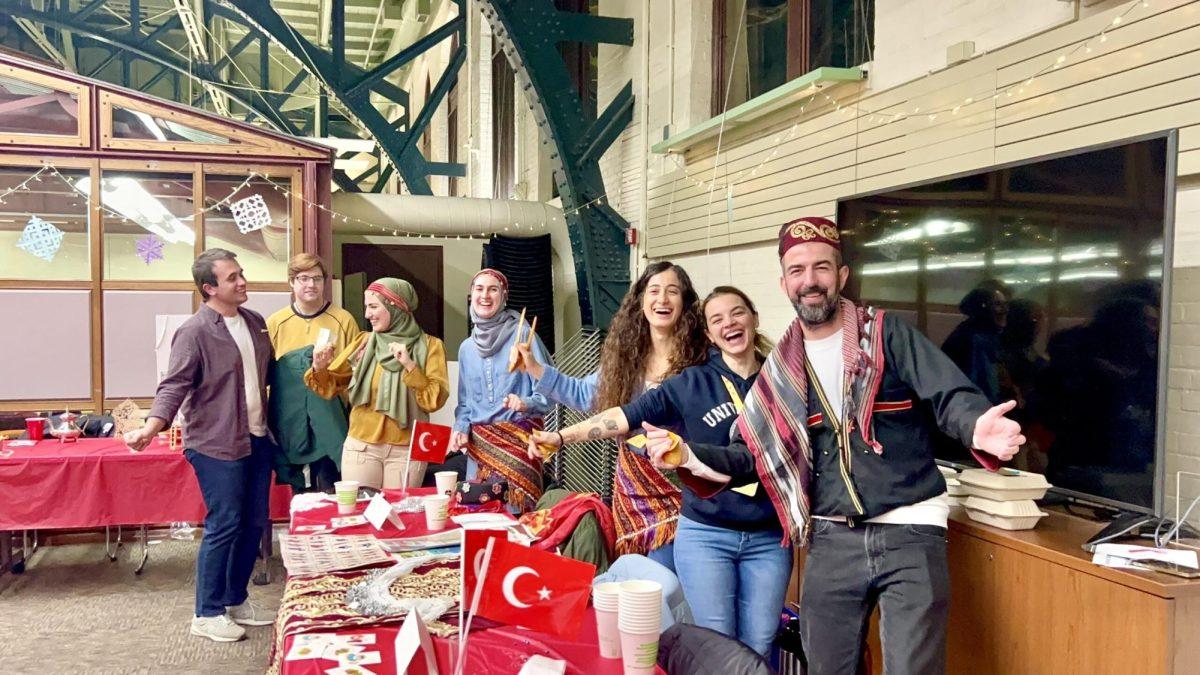Over 300 people gathered at the Multicultural Student Center Friday evening for “Night at the Bazaar,” the kickoff event for the second consecutive Middle East North Africa Heritage Month on the University of Wisconsin campus.
MENA students wearing traditional clothing ran booths from countries and regions like Persia, Somalia, North Africa, Kurdistan, Türkiye, the Levant and Gulf area countries. Each booth was decorated with flags and offered food from their respective country or region including Kurdish kibbeh, Moroccan sweets like chebakia, Turkish dürüm, Palestinian manakeesh and more.
As live Algerian music played, attendees participated in cultural activities like Arabic calligraphy, henna — dye that is used in many cultural celebrations, as hair dye or to decorate the body — and glass mosaics — common in Iran and Türkiye and often used to decorate religious buildings and mosques. A mother of one of the MENA community members taught tatreez, traditional Palestinian embroidery that varies in style by region and is important to Palestinian identity.
MENA Cultural Programming Intern Dana Tabaza said the night was an opportunity for MENA students to fall back in love with who they are.
“All we want to do is tell you about our cultures,” Tabaza said. “We want to share them with you. In our cultures, the well-being of yourself means nothing if the well-being of people in your community is not met. We’re trying to bring that same energy to what we do here.”
The event acknowledged this year’s MENA Heritage Month theme, “MENA in the Modern World,” which affirms the MENA region is dynamic, contemporary and diverse, but also appreciates its rich cultural history.
“Our history has often been the victim of foreign authorship,” the Collective wrote in their description of the theme. “MENA Heritage Month is a blank page for us to reclaim our stories, liberating ourselves from stereotypes and challenging perspectives that have often overshadowed the depth and complexity of our identities. In this, we honor the resilience embedded in our cultural tapestry.”
Dima Hamdan, who is Jordanian and was running the Arabic calligraphy booth, said she resonated with the theme.
“With the situation back home in the Middle East right now, we want to show there’s still a strong culture and a lot of modernity in the region,” Hamdan said. “Here in the U.S., we carry our culture with us. And back home, we’ve progressed further than people think we have.”
MENA community member Esraa Elshakra said she appreciated “Lanterns for Gaza,” where attendees could write prayers and messages for Gaza on paper lanterns that would then be lit and released into the sky on a later date. Tabaza said the collective, which has several Palestinian members, wanted to acknowledge the war in Gaza in a healing way during the event.
Over 30,640 Palestinians have died in the five months of war in Gaza — surpassing any Arab loss in wars with Israel in the past 40 years, according to the New York Times.
According to Tabaza, an important aspect of her job as MENA Cultural Programming Intern is ensuring all parts of the MENA community are represented.
“I know how much this community has suffered in the sphere of representation,” Tabaza said. “I want every person to come to our events and feel included. We have people from across the region, and almost every country is covered.”
Elshakra said the event was a great way to make MENA students feel included, despite not yet having a dedicated space in the MSC.
“It recognizes the different ethnic minorities within MENA, whether it be in the Middle East or North Africa,” Elshakra said.
Aziz Bayoudh, a UW student from Tunisia, said he always carries his country with him, and events like Night at the Bazaar help him share it with others.
The event is the first of seven throughout the month — Engineering Lunch March 5, Relief for Refugees March 7, NAS x MENAHM Iftar March 12, Craft Cafe March 13, Threads of Heritage March 18 and Thousand & One Nights March 21. All Heritage Month events are free, and can be found on the UW Events Calendar.
The event attracted students from UW, but also many families from around the Madison area. Collective member Lina Zehra Raouf, who is Turkish and Moroccan, said it feels good to watch the event she has helped plan since December turn to reality.
“It feels like the community was really united here tonight,” Raouf said. “It’s really nice seeing people celebrate with us and try our foods. Especially because we don’t have a space in the red gym, which is something we’ve really been pushing for. So by having big turnouts for events like these, we can kinda show the university there is a need for a space for us here because we do exist and there’s a lot of us.”


